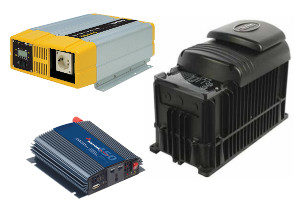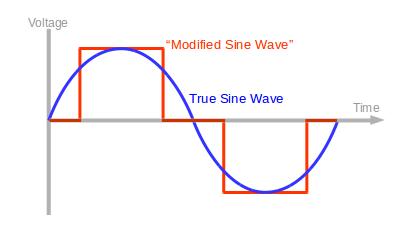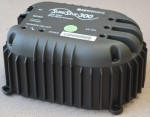Important Concepts
 Inverters convert the DC voltage of the batteries into the AC voltage your equipment expects.
Inverters convert the DC voltage of the batteries into the AC voltage your equipment expects.- Inverters are sized to handle the average and peak wattage of your equipment loads.
- Too small an inverter will fail quickly from overwork, too large an inverter will waste some of your power when it isn’t working very hard.
Choosing an inverter
The inverter needs to be designed to run on the DC voltage of your battery bank and put out the correct AC voltage for your equipment; usually 230V, 50Hz. You need to decide on those before shopping for inverters, then you need to calculate all your loads in watts.
True Sine Wave or “Modified Sine Wave”
 Cheaper inverters don’t put out a proper sine wave, but use simple on-off switching to approximate the power curve of a sine wave. They call this a “Modified Sine wave” but it’s really a modified square wave. This can cause unacceptable noise in some audio and radio equipment, and AC motors can overheat and burn out earlier than normal using a modified sine wave. Some medical devices and sensitive electronics devices could possibly have problems using a modified sine wave inverter. As a result, we can only recommend “true sine wave” inverters with confidence. However, many folks find they have few or no problems with a modified sine wave inverter; but you can’t really know for sure without trying it.
Cheaper inverters don’t put out a proper sine wave, but use simple on-off switching to approximate the power curve of a sine wave. They call this a “Modified Sine wave” but it’s really a modified square wave. This can cause unacceptable noise in some audio and radio equipment, and AC motors can overheat and burn out earlier than normal using a modified sine wave. Some medical devices and sensitive electronics devices could possibly have problems using a modified sine wave inverter. As a result, we can only recommend “true sine wave” inverters with confidence. However, many folks find they have few or no problems with a modified sine wave inverter; but you can’t really know for sure without trying it.
Dust & Fans cause early failures
We prefer to recommend inverters with closed cases and no fans since they last longer. Dust and ants get inside through the ventilation holes and fans fail after a couple years. Lasting longer = cheaper in the long run.
How many watts does it need to handle?
When sizing you inverter you need to consider a worst case scenario. Realistically, how many different fans lights computers etc. might you want to turn on at once in possible but maybe unusual circumstances. Suppose you’re having a group meeting or guests? Total up the number of watts of all that equipment and make sure the inverter can handle that many. Most people end up buying an inverter rated for about double their typical loads.
Not all inverters have the same “Engineering margin”
Be aware that some manufacturers are overly optimistic about their wattage ratings. Many of the cheaper brands will fail in a matter of months, or hours, if you actually load them up to the manufacturer’s rated watts, especially in a hot environment. Consider oversizing your inverter if you’re not sure of the quality. Better (and more expensive) brands like Outback and Morningstar can be run at rated capacity indefinitely and at double their rating for minutes at a time without damage.
Does the inverter include an adjustable LVD?
Many large inverters (> 1000W) have a settable low voltage disconnect (LVD). Check the user’s manual. If you can set the inverter to disconnect at 12.0V or so, you won’t need to purchase a separate LVD circuit, saving you money and complexity. (See our page on choosing LVDs.) Beware: most smaller 12V inverters will drain your battery too low before shutting off, quickly ruining it. You must install a LVD between the inverter and batteries to protect your battery investment.
 The Suresine 12V, 300 watt inverter has a built-in adjustable LVD, so you can skip the extra complexity and cost of a separate LVD.
The Suresine 12V, 300 watt inverter has a built-in adjustable LVD, so you can skip the extra complexity and cost of a separate LVD.
Larger systems should use a 24V or 48V battery bank
At ~1000W and above you can find 24V and 48V inverters. Running with a higher battery voltage has many advantages.
- Cables can be much smaller and longer without heavy losses. The extremely fat cables needed for a high capacity 12V system are stiff and very difficult to handle, hard to connect to, and difficult an expensive to obtain.
- Save money on charge controllers. The same MPPT charge controller can handle double the number of panels when charging a 24V battery or 4X as many with a 48V battery. Example: The Outback Flexmax 60 charge controller is limited to approximately 720W worth of solar panels with a 12V battery, (12V x 60A = 720W) If you need more panels than that you’ll have to buy multiple charge controllers and hook them in parallel. But with a 48V battery bank the exact same Flexmax 60 charge controller can handle 2880W of solar panels.
- You can build a much higher capacity battery bank without exceeding the 3 strings in parallel rule. If the largest batteries you can find locally are 12V 200Ah, three in parallel only gets you 2400Wh of usable capacity. But you can build a 48V battery bank using them in 3 strings giving 9600Wh. Use our battery balancer to keep the individual batteries in each series evenly charged.
Inverters are only about 85% efficient
This varies a bit, but you need to add another ~18% to your watt hour calculations if your loads are going through an inverter because an inverter wastes that much as heat before the loads get the power. However, for larger systems this can be more efficient than trying to run 12V DC cables all over a building. The losses in the 12V DC cables can be very high unless you use extremely fat wires, which may be hard to source in your area.

 GTIS Power and Communications Systems
GTIS Power and Communications Systems